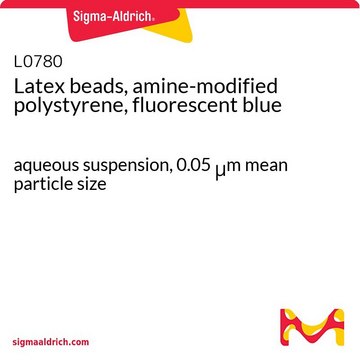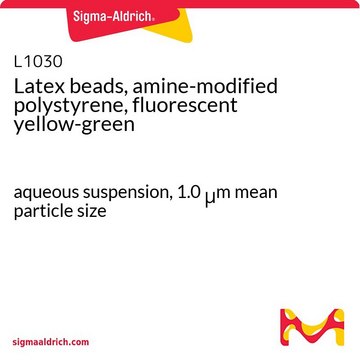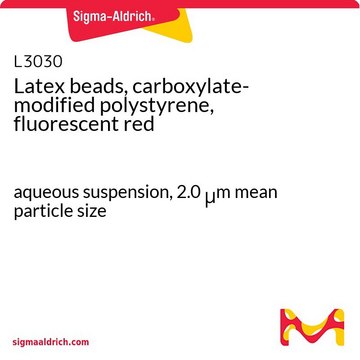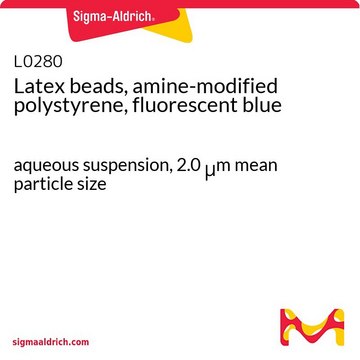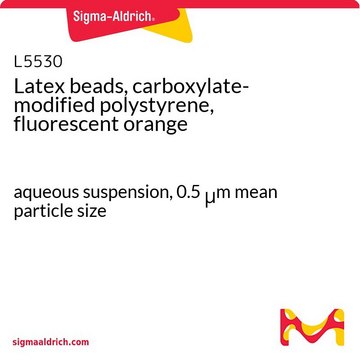L9904
Latex beads, amine-modified polystyrene, fluorescent orange
aqueous suspension, 0.1 μm mean particle size
Synonym(s):
Amine-Modified Latex Beads, Fluorescent Orange Beads
Sign Into View Organizational & Contract Pricing
All Photos(1)
About This Item
Recommended Products
form
aqueous suspension
Quality Level
composition
Solids, 2.5%
technique(s)
cell based assay: suitable
mean particle size
0.1 μm
fluorescence
λex ~475 nm; λem ~540 nm
application(s)
cell analysis
Looking for similar products? Visit Product Comparison Guide
Application
Amine-modified polystyrene latex beads have been used to develop an electrochemical nitrite nanosensor as well as to validate a pharyngeal aspiration technique for exposing the mouse lung to respirable particles.
Latex beads, amine-modified polystyrene, fluorescent orange has been used in the preparation of nano-particles in biophysical characterization. It has also been used in the preparation of nano-particles for cytotoxicity studies in yeast and cell lines.
Storage Class
10 - Combustible liquids
wgk_germany
WGK 3
flash_point_f
Not applicable
flash_point_c
Not applicable
Certificates of Analysis (COA)
Search for Certificates of Analysis (COA) by entering the products Lot/Batch Number. Lot and Batch Numbers can be found on a product’s label following the words ‘Lot’ or ‘Batch’.
Already Own This Product?
Find documentation for the products that you have recently purchased in the Document Library.
Customers Also Viewed
Toshiyuki Nomura et al.
Chemosphere, 149, 84-90 (2016-02-09)
The effects of surface physicochemical properties of functionalized polystyrene latex (PSL) nanoparticles (NPs) and model filamentous fungi Aspergillus oryzae and Aspergillus nidulans cultivated in different environment (aqueous and atmospheric environment) on the colloidal behavior and cytotoxicity were investigated in different
Exposure of the yeast Saccharomyces cerevisiae to functionalized polystyrene latex nanoparticles: influence of surface charge on toxicity
Nomura T, et al.
Environmental Science & Technology, 47(7), 3417-3423 (2013)
Esen Efeoglu et al.
The Analyst, 142(18), 3500-3513 (2017-08-24)
Nanotoxicology has become an established area of science due to growing concerns over the production and potential use of nanomaterials in a wide-range of areas from pharmaceutics to nanomedicine. Although different cytotoxicity assays have been developed and are widely used
Edwin H Shin et al.
Nanoscale, 5(13), 5879-5886 (2013-05-24)
The use of nanoparticles for cellular therapeutic or sensing applications requires nanoparticles to bind, or adhere, to the cell surface. While nanoparticle parameters such as size, shape, charge, and composition are important factors in cellular binding, the cell itself must
G V S Rao et al.
Journal of toxicology and environmental health. Part A, 66(15), 1441-1452 (2003-07-15)
Recent studies have demonstrated that the mouse lung can be exposed to soluble antigens by aspiration of these antigens from the pharynx. This simple technique avoids the trauma associated with intratracheal instillation. In this study, the pharyngeal aspiration technique was
Our team of scientists has experience in all areas of research including Life Science, Material Science, Chemical Synthesis, Chromatography, Analytical and many others.
Contact Technical Service